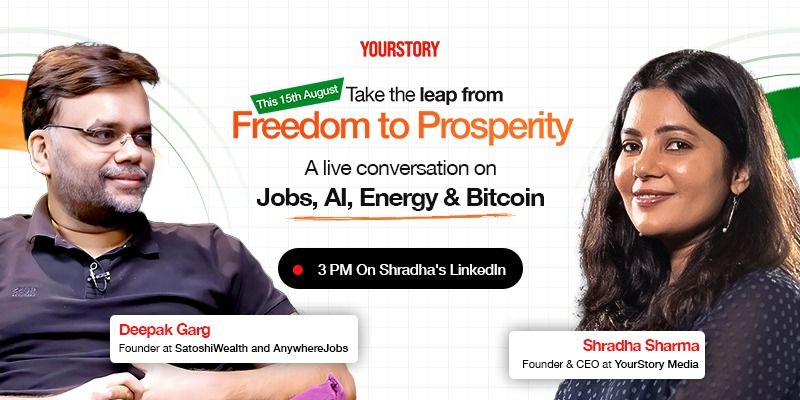
With over 100 million cryptocurrency owners and a blockchain market projected to grow exponentially, India stands at a technological crossroads on its 79th Independence Day—will emerging technologies like blockchain and artificial intelligence digitise existing systems, or fundamentally transform how India’s 1.4 billion citizens work, invest, and build wealth?
In a thought-provoking live conversation, Shradha Sharma, Founder and CEO of YourStory, sat down with Deepak Garg, Founder of SatoshiWealth and AnywhereJobs, to decode how AI and blockchain could reshape India’s economic trajectory and shape the nation’s next leap forward.
Garg, a serial entrepreneur and investor, believes India must assess global demographic and economic shifts before charting its technological discourse.
“We're a country where the young population is increasing every year, with 20 million youths joining the job age. While the world is ageing, India is becoming younger. There's an ageing phenomenon happening in the world. There's a demographic shift happening in the world over the next 10 years,” he explains.
The skills migration opportunity
According to Garg, about 300 million jobs will be created over the next 10 to 20 years in the West due to ageing populations—a number that almost mirrors young people entering India's job market during the same period.
Calling it a “skill migration corridor", he believes that it lays a structured pathway for Indian workers to access opportunities across the world.
“A truck driver in India earns $300-400 per month, while a truck driver in Europe earns $3,000-4,000 monthly. That's a 10X jump. That's a skilled migration corridor of a truck driver,” he explains.
It was the same vision that led Garg to found AnywhereJobs—a skilling and employment platform designed to offer global work opportunities for skilled Indian professionals.
“Last year, we sent 3,000 truck drivers to Germany. Each of them is sending back $2,000 to $2,500 home. Their lives are changing completely. Their kids are getting educated in better schools. They're building houses in their villages. Many of them, after working for 3-4 years, come back and retire, or set up their own business,” he adds.
Additionally, he highlights how numerous European countries, the US, Canada, Australia, South Korea, and Japan are actively looking for talent due to age gaps.
Garg is best known for building logistics firm Rivigo and turning it into one of the country’s fastest unicorns between 2014 and 2017. A former McKinsey consultant with eight years of experience, Garg holds degrees from IIT Kanpur and IIM Lucknow.
Fueling AI with energy power
During his Independence Day address today, Prime Minister Narendra Modi said India's first domestically manufactured semiconductor chip would be launched by the end of 2025. He also announced plans to increase India’s nuclear power generation capacity 10-fold over the next two decades.
Stressing that energy infrastructure must be the primary focus for any country building its own AI infrastructure, Garg says, “We are entering a world where AI and blockchain are the new arc of evolution. Energy is the fundamental currency of all of this. The more energy a nation has, the more powerful it is.”
Garg further urges India to take inspiration from China, highlighting it as a prime example of how a nation can rapidly expand its energy capacity through sustained policy focus and large-scale investments.
“However, our production is still not growing at the same pace as China’s. [It] has increased its energy production by 20% last year. The amount of solar power China has installed in the last year is 464 GW, which is almost five times the total lifetime installed capacity of solar in India,” he added.
Meanwhile, the country is on track to nearly double its nuclear power capacity by 2040. A latest report by China Nuclear Energy Association (CNEA) reveals the plan calls for dozens of new reactors, lifting installed capacity to 200 GW—more than twice the current capacity of the US—by the end of the next decade.
“They're doubling their nuclear energy in the next five years. We need a big energy mission. It can't be 6-7% growth. We need to bring avenues to make energy investment profitable again,” Garg says.
Convergence of AI and Web3
According to an IMARC report, India's cryptocurrency market was valued at $2.6 billion in 2024 and is projected to reach $13.9 billion by 2033.
Garg, being particularly bullish on Bitcoin's potential, says, “People should take time and study Bitcoin—I believe it will provide the highest return on your time. It's a genius idea that solves all the issues which exist in the fiat world.”
The serial entrepreneur views Bitcoin as a superior store of value compared to traditional assets, like gold, emphasising its deflationary nature and fixed supply.
"The profound principle is that scarcity creates value. Bitcoin is the purest, soundest money. It protects your hard-earned money. It doesn’t inflate and has no supply inflation, which helps you retain the value,” he says.
Looking towards the future, Garg envisions a convergence between artificial intelligence and blockchain technology.
“AI and Web3 must evolve together. Blockchain brings trust and data integrity to the AI world. AI agents will operate in a Web3 and blockchain environment, requiring decentralised protocols,” he adds.
Edited by Suman Singh
Original Article
(Disclaimer – This post is auto-fetched from publicly available RSS feeds. Original source: Yourstory. All rights belong to the respective publisher.)